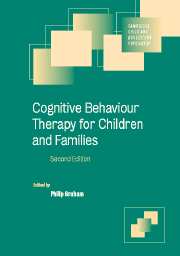Book contents
- Frontmatter
- Contents
- List of contributors
- 1 Introduction
- Part I Developmental cognitive theory and clinical practice
- Part II Engagement and assessment
- Part III Client groups
- Part IV Applications in psychosocial adversity
- Part V Applications in specific child and adolescent psychiatric disorders
- 12 Behavioural approaches to eating and sleeping problems in young children
- 13 Conduct disorders in young children
- 14 Attention deficit hyperactivity disorder
- 15 Children with developmental disabilities and their parents
- 16 Depressive disorders
- 17 Cognitive behavioural psychotherapy for obsessive compulsive disorders
- 18 Anxiety disorders
- 19 School refusal
- 20 Post-traumatic stress disorders
- 21 Disorders of eating control
- 22 Chronic fatigue syndrome
- 23 Children's interpersonal problems
- 24 Pain in childhood
- 25 Conduct disorders in adolescence
- 26 Drug and alcohol abuse
- Part VI CBT applications in preventive interventions
- Index
- References
25 - Conduct disorders in adolescence
Published online by Cambridge University Press: 21 August 2009
- Frontmatter
- Contents
- List of contributors
- 1 Introduction
- Part I Developmental cognitive theory and clinical practice
- Part II Engagement and assessment
- Part III Client groups
- Part IV Applications in psychosocial adversity
- Part V Applications in specific child and adolescent psychiatric disorders
- 12 Behavioural approaches to eating and sleeping problems in young children
- 13 Conduct disorders in young children
- 14 Attention deficit hyperactivity disorder
- 15 Children with developmental disabilities and their parents
- 16 Depressive disorders
- 17 Cognitive behavioural psychotherapy for obsessive compulsive disorders
- 18 Anxiety disorders
- 19 School refusal
- 20 Post-traumatic stress disorders
- 21 Disorders of eating control
- 22 Chronic fatigue syndrome
- 23 Children's interpersonal problems
- 24 Pain in childhood
- 25 Conduct disorders in adolescence
- 26 Drug and alcohol abuse
- Part VI CBT applications in preventive interventions
- Index
- References
Summary
In this chapter, the nature of conduct disorder and its symptoms will be reviewed briefly, and then an overview of a set of child, family, peer and community risk factors that can predict the emergence of serious antisocial behaviour in youth will be provided. Based on the contextual social–cognitive risk factors that have been implicated in the development of antisocial behaviour, a set of empirically supported cognitive behavioural interventions have been developed for youths from pre-adolescence through to the adolescent age periods. These programmes will be discussed, along with the research indicating their effectiveness.
Conduct disorder
The fourth edition of the Diagnostic and Statistical Manual of Mental Disorders (DSM-IV; American Psychiatric Association, 1994) defines conduct disorder (CD) as symptoms consisting of aggressive conduct that threatens physical harm to other people or animals or non-aggressive conduct that causes property loss or damage, deceitfulness and theft and serious violations of rules. CD is a repetitive and persistent pattern of behaviour which violates societal norms or the basic rights of others. These serious conduct problems are differentiated from oppositional defiant disorder which represents a recurrent pattern of defiant and disobedient behaviour (see Chapter 13). In the USA, rates of CD are estimated to be in the range of 6–16% for boys and 2–9% for girls (American Psychiatric Association, 1994), and to be more prevalent in boys than girls at a rate of about 3:1 (Kazdin, 1998).
- Type
- Chapter
- Information
- Cognitive Behaviour Therapy for Children and Families , pp. 443 - 458Publisher: Cambridge University PressPrint publication year: 2004



